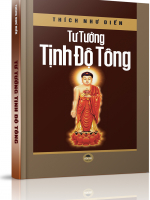Kẻ ngu dầu trọn đời được thân cận bậc hiền trí cũng không hiểu lý pháp, như muỗng với vị canh.Kinh Pháp Cú - Kệ số 64
Mặc áo cà sa mà không rời bỏ cấu uế, không thành thật khắc kỷ, thà chẳng mặc còn hơn.Kinh Pháp cú (Kệ số 9)
Nên biết rằng tâm nóng giận còn hơn cả lửa dữ, phải thường phòng hộ không để cho nhập vào. Giặc cướp công đức không gì hơn tâm nóng giận.Kinh Lời dạy cuối cùng
Chớ khinh tội nhỏ, cho rằng không hại; giọt nước tuy nhỏ, dần đầy hồ to! (Do not belittle any small evil and say that no ill comes about therefrom. Small is a drop of water, yet it fills a big vessel.)Kinh Đại Bát Niết-bàn
"Nó mắng tôi, đánh tôi, Nó thắng tôi, cướp tôi." Ai ôm hiềm hận ấy, hận thù không thể nguôi.Kinh Pháp cú (Kệ số 3)
Khi ăn uống nên xem như dùng thuốc để trị bệnh, dù ngon dù dở cũng chỉ dùng đúng mức, đưa vào thân thể chỉ để khỏi đói khát mà thôi.Kinh Lời dạy cuối cùng
Con tôi, tài sản tôi; người ngu sinh ưu não. Tự ta ta không có, con đâu tài sản đâu?Kinh Pháp Cú (Kệ số 62)
Không thể lấy hận thù để diệt trừ thù hận. Kinh Pháp cú
Giặc phiền não thường luôn rình rập giết hại người, độc hại hơn kẻ oán thù. Sao còn ham ngủ mà chẳng chịu tỉnh thức?Kinh Lời dạy cuối cùng
Cái hại của sự nóng giận là phá hoại các pháp lành, làm mất danh tiếng tốt, khiến cho đời này và đời sau chẳng ai muốn gặp gỡ mình.Kinh Lời dạy cuối cùng
Người thực hành ít ham muốn thì lòng được thản nhiên, không phải lo sợ chi cả, cho dù gặp việc thế nào cũng tự thấy đầy đủ.Kinh Lời dạy cuối cùng
Trang chủ »» Kinh Bắc truyền »» Bản Việt dịch Đại Thừa Bá Pháp Minh Môn Luận [大乘百法明門論] »»
Kinh điển Bắc truyền »» Bản Việt dịch Đại Thừa Bá Pháp Minh Môn Luận [大乘百法明門論]
 » Tải tất cả bản dịch (file RTF)
» Việt dịch (1) » Hán văn » Phiên âm Hán Việt
» Càn Long (PDF, 0.04 MB) » Vĩnh Lạc (PDF, 0.06 MB)
» Tải tất cả bản dịch (file RTF)
» Việt dịch (1) » Hán văn » Phiên âm Hán Việt
» Càn Long (PDF, 0.04 MB) » Vĩnh Lạc (PDF, 0.06 MB) 
Shastra on the Door to Understanding the Hundred Dharmas
Translated by: The Buddhist Text Translation Society
What are all Dharmas, and what is meant by having no self? All Dharmas may be generally grouped into five categories:
1. Mind Dharmas
2. Dharmas interactive with the Mind
3. Form Dharmas
4. Dharmas not interactive with the Mind
5. Unconditioned Dharmas
They are in this sequence because the first are supreme, the second interact with the first, the third are the shadows manifest by the previous two, the fourth are the positions in which the previous three are not found, and the last are revealed by the previous four.
The first, Mind Dharmas, include in general eight:
1. The Eye Consciousness
2. The Ear Consciousness
3. The Nose Consciousness
4. The Tongue Consciousness
5. The Body Consciousness
6. The Mind Consciousness
7. The Manas Consciousness
8. The Alaya Consciousness
The second, Dharmas interactive with the Mind, include in general fifty-one. They are divided into six categories:
1. The five universally interactive
2. The five particular states
3. The eleven wholesome
4. The six fundamental afflictions
5. The twenty derivative afflictions
6. The four unfixed
The five particular states are:
1. Desire
2. Resolution
3. Recollection
4. Concentration
5. Judgment
The eleven wholesome Dharmas are:
1. Faith
2. Vigor
3. Shame
4. Remorse
5. Absence of greed
6. Absence of anger
7. Absence of stupidity
8. Light ease
9. Non-laxness
10. Renunciation
11. Non-harming
The six fundamental afflictions are:
1. Greed
2. Anger
3. Stupidity
4. Arrogance
5. Doubt
6. Improper views
The twenty derivative afflictions are:
1. Wrath
2. Hatred
3. Rage
4. Covering
5. Deceit
6. Flattery
7. Conceit
8. Harming
9. Jealousy
10. Stinginess
11. Lack of shame
12. Lack of remorse
13. Lack of faith
14. Laziness
15. Laxness
16. Torpor
17. Restlessness
18. Distraction
19. Improper knowledge
20. Scatteredness
The four unfixed are:
1. Sleep
2. Regret
3. Examination
4. Investigation
The third category is the Form Dharmas. In general there are eleven kinds:
1. Eyes
2. Ears
3. Nose
4. Tongue
5. Body
6. Forms
7. Sounds
8. Smells
9. Flavors
10. Objects of touch
11. Dharmas pertaining to form
The fourth category is the Dharmas not interactive with the Mind. In general, there are twenty-four:
1. Attainment (acquisition)
2. Life-faculty
3. Generic similarity
4. Dissimilarity
5. The no thought samadhi
6. The samadhi of extinction
7. The reward of no thought
8. Bodies of phonemes`
9. Bodies of sentence
10. Bodies of phonemes
11. Birth
12. Dwelling
13. Aging
14. Impermanence
15. Revolution
16. Distinction
17. Interaction
18. Speed
19. Sequence
20. Tim
21. Direction
22. Numeration
23. Combination
24. Discontinuity
The fifth category is the Unconditioned Dharmas of which there are, in general, six:
1. Unconditioned empty space
2. Unconditioned extinction which is attained by selection
3. Unconditioned extinction which is unselected
4. Unconditioned unmoving extinction
5. Unconditioned extinction of feeling and thinking
6. Unconditioned True Suchness
What is meant by there being no self? There are in general, two kinds of Non-self:
1. The Non-self of Pudgala
2. The Non-self of Dharmas
MUA THỈNH KINH SÁCH PHẬT HỌC
DO NXB LIÊN PHẬT HỘI PHÁT HÀNH
Mua sách qua Amazon sẽ được gửi đến tận nhà - trên toàn nước Mỹ, Canada, Âu châu và Úc châu.
Quý vị đang truy cập từ IP 216.73.216.28 và chưa ghi danh hoặc đăng nhập trên máy tính này. Nếu là thành viên, quý vị chỉ cần đăng nhập một lần duy nhất trên thiết bị truy cập, bằng email và mật khẩu đã chọn.
Chúng tôi khuyến khích việc ghi danh thành viên ,để thuận tiện trong việc chia sẻ thông tin, chia sẻ kinh nghiệm sống giữa các thành viên, đồng thời quý vị cũng sẽ nhận được sự hỗ trợ kỹ thuật từ Ban Quản Trị trong quá trình sử dụng website này.
Việc ghi danh là hoàn toàn miễn phí và tự nguyện.
Ghi danh hoặc đăng nhập


 Trang chủ
Trang chủ


